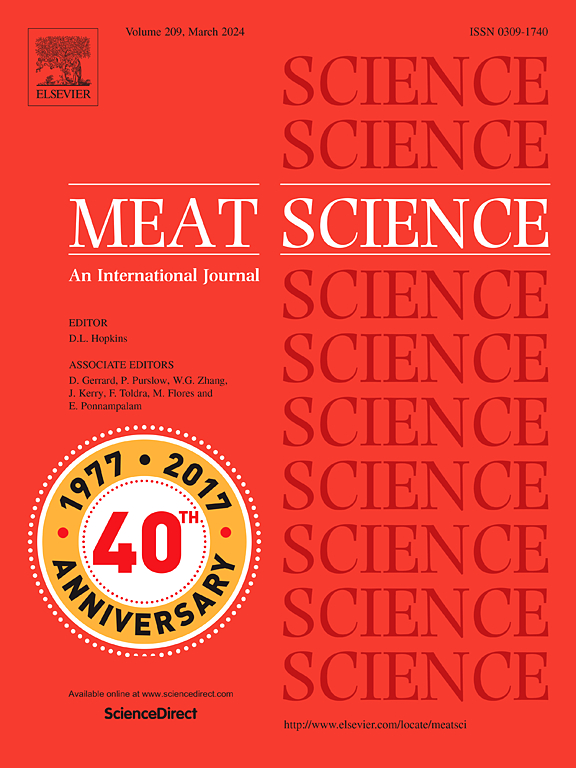Determination of Warner-Bratzler shear force thresholds for classifying meat tenderness of Kivircik lambs: A study in Türkiye
IF 6.1
1区 农林科学
Q1 Agricultural and Biological Sciences
引用次数: 0
Abstract
The aims of the study were to identify the Warner-Bratzler Shear Force (WBSF) threshold value that corresponds to the transition from perceived tenderness to toughness in lamb meat through sensory panel evaluations, and to compare the classification performances of the threshold values determined using linear regression and Receiver Operating Characteristic (ROC) analysis methods. The study data comprised WBSF analysis results of the longissimus thoracis et lumborum muscle from 405 Kivircik lambs, along with tenderness scores determined by a trained sensory panel. WBSF threshold values were determined separately for the “panellists' sensory tenderness evaluation dataset (raw dataset; n=3049)” and the “mean score dataset created by averaging the tenderness scores given by the panellists for each lamb (individual lamb dataset; n=405)”. Higher classification accuracy was achieved in the mean score dataset compared to the individual score dataset using both linear regression and ROC analysis methods. The WBSF threshold value for the mean score dataset was determined as 40.9 N by ROC analysis and 48.0 N by linear regression analysis. The accuracy of these threshold values was calculated to be 82.2 % and 85.4 %, respectively. The threshold value based on ROC analysis provided higher sensitivity and negative predictive value, whereas the threshold value based on regression analysis was advantageous in terms of specificity and positive predictive value.
基维克羔羊肉嫩度分类的Warner-Bratzler剪切力阈值的测定:一项在基耶耶的研究。
本研究的目的是通过感官面板评估确定羊肉从感知嫩度到韧度转变对应的Warner-Bratzler剪切力(WBSF)阈值,并比较采用线性回归和接受者工作特征(ROC)分析方法确定的阈值的分类性能。研究数据包括405只Kivircik羔羊胸腰最长肌的WBSF分析结果,以及由训练过的感觉小组确定的压痛评分。WBSF阈值分别为“小组成员的感官压痛评估数据集(原始数据集;n=3049)”和“通过平均小组成员对每只羔羊给出的压痛评分创建的平均评分数据集(单个羔羊数据集;n=405)”确定。与使用线性回归和ROC分析方法的个体得分数据集相比,平均得分数据集实现了更高的分类精度。平均评分数据集的WBSF阈值经ROC分析为40.9 N,线性回归分析为48.0 N。这些阈值的准确率分别为82.2%和85.4%。基于ROC分析的阈值具有更高的敏感性和阴性预测值,而基于回归分析的阈值在特异性和阳性预测值方面具有优势。
本文章由计算机程序翻译,如有差异,请以英文原文为准。
求助全文
约1分钟内获得全文
求助全文
来源期刊

Meat Science
工程技术-食品科技
CiteScore
12.60
自引率
9.90%
发文量
282
审稿时长
60 days
期刊介绍:
The aim of Meat Science is to serve as a suitable platform for the dissemination of interdisciplinary and international knowledge on all factors influencing the properties of meat. While the journal primarily focuses on the flesh of mammals, contributions related to poultry will be considered if they enhance the overall understanding of the relationship between muscle nature and meat quality post mortem. Additionally, papers on large birds (e.g., emus, ostriches) as well as wild-captured mammals and crocodiles will be welcomed.
 求助内容:
求助内容: 应助结果提醒方式:
应助结果提醒方式:


